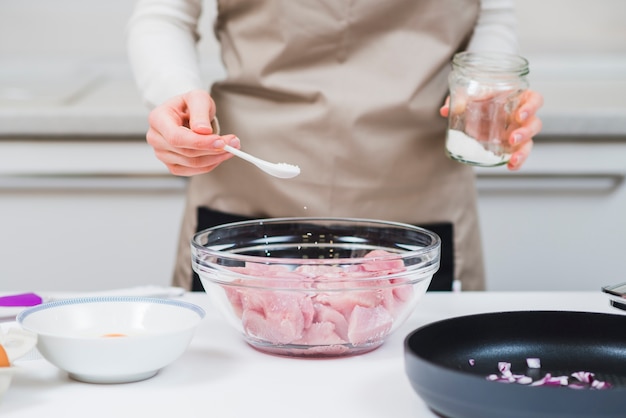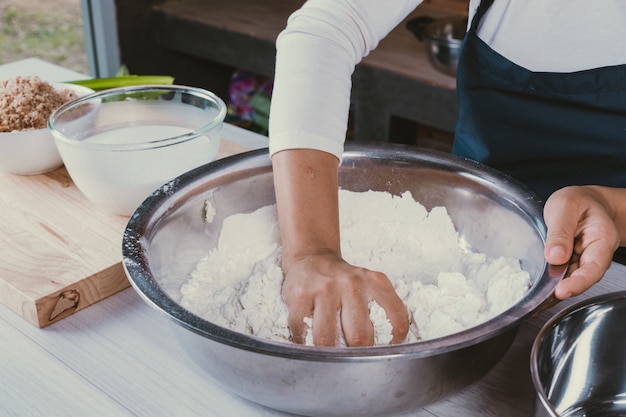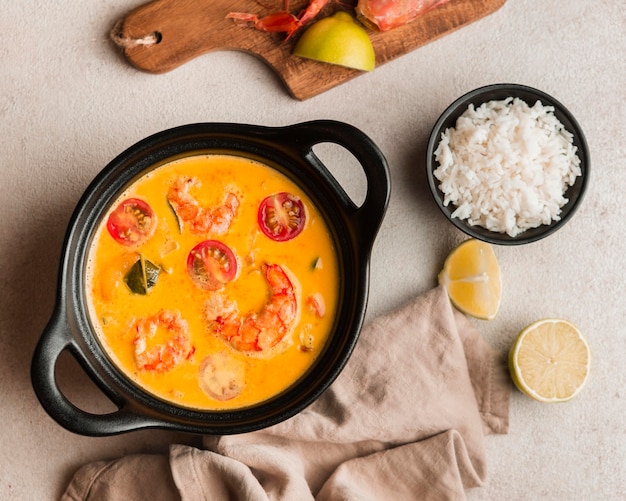Rice. It’s a staple in countless kitchens worldwide, a versatile blank canvas for flavour, and a comforting side dish that never fails to please. But for years, my rice-making efforts were a frustrating dance between mushy gloop and dry, crumbly disappointment. I felt like a culinary failure whenever I attempted to whip up a pot of this seemingly simple grain.
Then, one day, I stumbled upon a method that transformed my rice-cooking experience. No more soggy disasters or crunchy failures. This newfound technique consistently delivered fluffy, perfectly cooked rice, every single time. I was ecstatic! Now, I'm sharing this foolproof method with you. I'll guide you through each step, from choosing the right rice to mastering the art of the final fluff.
So, are you ready to join me on this culinary journey to achieve perfect stovetop rice? Let's get started!
(Part 1) The Rice You Choose Matters: Understanding Your Options

Like any good relationship, crafting perfect rice starts with choosing the right partner – in this case, the right rice. There's a whole world of varieties out there, each with its own personality and quirks. Let's break down some of the most common types:
long grain rice: The Workhorse of the Rice World
This is the rice you'll likely find in most supermarkets. It has long, slender grains that separate easily when cooked, resulting in a fluffy, light texture. Long grain rice is a true chameleon, perfect for stir-fries, curries, rice salads, and even as a base for hearty rice bowls. It's my go-to choice for everyday use.
medium grain rice: A Chewy Delight
Medium grain rice has shorter, wider grains compared to its long grain cousin. When cooked, it's slightly chewier and stickier, making it ideal for sushi, where the grains need to cling together for perfect rolls. It also shines in rice puddings, offering a comforting, creamy texture.
short grain rice: The Sticky Master
Short grain rice takes the crown for being the stickiest of the bunch. Its short, round grains create a cohesive, almost gluey texture when cooked, making it the perfect choice for rice balls, where the grains need to hold their shape. It's also a popular choice for japanese rice dishes.
brown rice: The Nutrient-Packed Hero
Brown rice is a whole grain rice, meaning it hasn't been polished like its white counterpart. This gives it a nutty flavour and a slightly chewy texture. Brown rice is packed with nutrients, making it a healthier choice. The only caveat is it takes a bit longer to cook than its white counterpart, but it's well worth the extra time for its flavour and nutritional benefits.
For my everyday needs, I usually stick to long grain rice. But don't be afraid to explore other varieties! Experiment with different types to find your personal favourites and discover the world of rice beyond the familiar.
(Part 2) A Rinse for a Better Rice: The Importance of Washing Away Excess Starch

While it may seem like a mundane step, rinsing your rice is crucial for achieving fluffy, non-sticky rice. The starch on the surface of the rice can cause it to clump together during cooking, creating a sticky, undesirable mess. By rinsing it, you wash away the excess starch, ensuring that the rice cooks evenly and separates beautifully.
Here's a simple guide to rinsing your rice:
- Grab your trusty sieve: Place the rice in a fine-mesh sieve.
- Cold water is key: Rinse the rice under cold running water until the water runs clear, indicating that most of the starch has been removed.
- Shake off the excess: Once the water runs clear, gently shake off any remaining water and set the rice aside. Your rice is now ready for the next step!
(Part 3) The Magic Ratio: Finding the Perfect Balance Between Rice and Water

Here lies the secret to perfectly cooked rice – the right water-to-rice ratio. Too much water, and your rice will turn into a mushy mess. Too little, and it'll be dry and crunchy. The sweet spot? I've found that for long grain rice, the magic ratio is 1 cup of rice to 1 and 3/4 cups of water. This ratio has consistently delivered perfect results for me.
Don't be intimidated if you're cooking a larger batch. Simply multiply the quantities accordingly. For example, if you're making 2 cups of rice, use 3 and 1/2 cups of water. This simple formula ensures that your rice cooks perfectly, regardless of the amount you're making.
(Part 4) Bringing the Magic to Life: The Art of Cooking Perfect Rice
Now comes the fun part – cooking the rice! A medium-sized saucepan with a tight-fitting lid is your trusty companion in this culinary adventure. Here's how to bring your rice to life:
- Heat the water: Heat the water in the saucepan over medium-high heat. You want the water to come to a rolling boil.
- Introduce the rice: Once the water is boiling, gently add the rinsed rice and stir gently to ensure even distribution.
- Simmer and seal: Bring the water back to a boil, then reduce the heat to low, cover the saucepan with the lid, and simmer for 15 minutes without lifting the lid. This is crucial for allowing the rice to cook evenly.
- Resting is key: After 15 minutes, remove the saucepan from the heat and let the rice sit, covered, for another 5 minutes. This crucial resting period allows the rice to absorb any remaining liquid and become perfectly fluffy.
That's it! You've just cooked perfect rice. Now, it's time for the finishing touch.
(Part 5) Fluffing for Perfection: The Final Touch
After the rice has rested, it's time for the final flourish – fluffing! This step transforms the rice from a compact clump to a light, airy delight. Simply use a fork to gently separate the rice grains, creating that perfect, fluffy texture that's a joy to eat.
For an extra boost of flavour, you can add a pinch of salt to the water before you start cooking. This will enhance the rice's natural flavour, making it taste even more delicious.
(Part 6) The Stage is Set: Serving and Storing Your Rice Masterpiece
With your rice cooked to perfection, it's time to showcase its culinary magic! I love serving it with a variety of dishes, from vibrant curries to sizzling stir-fries and refreshing salads. It's a blank canvas, ready to be adorned with your culinary creativity.
For a little extra flavour, add a splash of soy sauce or sesame oil to the rice. The possibilities are endless! If you have leftover rice, store it in an airtight container in the refrigerator for up to 3 days. Remember to let it cool completely before storing to prevent moisture buildup. When you're ready to enjoy it again, gently reheat it in the microwave or on the stovetop.
(Part 7) Common rice cooking Missteps: Avoiding Culinary Disasters
Even the most seasoned cooks can make mistakes. Let's face it, rice can be a bit of a diva. But fear not! Understanding common errors can help you avoid culinary disasters and ensure your rice is a triumph.
Overcooked Rice: A Mushy Mishap
Overcooked rice is a culinary tragedy. It's mushy, sticks together, and lacks the desired texture. This happens when you cook the rice for too long. To avoid this, stick to the recommended cooking time. If you're unsure, err on the side of caution. A few extra minutes can always be added later, but it's harder to undo overcooking.
Undercooked Rice: A Crunchy Crisis
Undercooked rice is equally unwelcome. It's hard, crunchy, and doesn't offer the desired soft texture. This occurs when you don't cook the rice for long enough. Check the rice after the recommended cooking time to ensure it's cooked through. If it's still crunchy, add a few more minutes to the cooking time.
Not Rinsing the Rice: The Sticky Situation
Remember those pesky starch particles? Not rinsing your rice can result in a sticky, clumpy mess. Make sure to rinse your rice thoroughly to remove excess starch. This simple step goes a long way towards achieving fluffy, separated rice.
Sticking Rice: A Pot-Bottom Tragedy
A common frustration is rice sticking to the bottom of the saucepan. This usually happens due to insufficient rinsing or not enough water. Make sure to rinse the rice thoroughly and use the correct water-to-rice ratio. Adding a tablespoon of oil to the saucepan before adding the rice can also help create a barrier to prevent sticking.
(Part 8) Beyond the Basics: Embracing rice variations and Experimentation
Don't limit yourself to the standard rice experience! There's a whole world of flavour and texture waiting to be explored. Experiment with herbs, spices, vegetables, and even different cooking methods to create your own signature rice dishes.
Here are a few ideas to get you started:
- Herbed Rice: Add a handful of fresh herbs, such as parsley, dill, or chives, to the rice while it's cooking for a burst of aromatic flavour.
- Spiced Rice: Introduce a pinch of your favourite spices, like cumin, coriander, or turmeric, to the rice during cooking for an exotic twist.
- Vegetable Rice: Chop up some of your favourite vegetables, such as onions, carrots, or peas, and add them to the rice while cooking for a nutritious and flavorful boost.
- Broth Rice: Elevate your rice game by replacing the water with chicken or vegetable broth for a richer, more flavourful result.
Be adventurous and experiment! You might discover your new favourite rice dish, impressing your friends and family with your newfound rice-cooking prowess.
(Part 9) Elevate Your Rice Game: Extra Tips for Stellar Results
Here are some additional tips to make your rice even better:
- Invest in quality: The quality of your rice will significantly impact the final result. Choose fresh rice, free from any signs of damage or spoilage. You'll notice the difference in flavour and texture.
- Gentle hands: Over-stirring the rice can break the grains, resulting in a mushy texture. Stir it gently only once or twice during the cooking process.
- Patience is key: After the rice has finished cooking, let it sit, covered, for 5 minutes before fluffing. This allows the rice to absorb any remaining liquid and become perfectly fluffy.
- Store with care: Store leftover rice in an airtight container in the refrigerator for up to 3 days. Remember to let it cool completely before storing.
(Part 10) FAQs: Answering Your Rice-Related Questions
It's time to address some common rice-related questions. Let's clear up any confusion and equip you with the knowledge you need to conquer your rice-cooking journey.
1. Can I use a rice cooker instead of a saucepan?
Absolutely! Rice cookers are designed specifically for cooking rice and often deliver excellent results. They offer a hands-off approach, making them a convenient option for busy kitchens. However, the magic of stovetop cooking lies in the control it offers. You can adjust the cooking time and water amount based on your preferences.
2. Can I cook different types of rice in the same way?
Not always. different rice types have different cooking times and water-to-rice ratios. For types other than long grain rice, carefully consult the package instructions for the most accurate cooking method.
3. What if I don't have the right water-to-rice ratio?
Don't worry! If you've added too much water, simmer the rice for a few extra minutes to allow it to absorb the excess liquid. If you've added too little water, carefully add a little more and continue cooking until the rice is cooked through.
4. How can I prevent the rice from sticking to the bottom of the saucepan?
Thoroughly rinsing the rice is a good starting point. You can also add a tablespoon of oil to the saucepan before adding the rice, creating a barrier between the rice and the saucepan.
5. What are some good side dishes to serve with rice?
Rice is a versatile side dish. Popular choices include curries, stir-fries, salads, and roasted vegetables. Get creative! You can also use rice as a base for rice bowls or rice salads, incorporating a variety of ingredients.
Armed with this knowledge, you're ready to conquer the world of stovetop rice. Remember, practice makes perfect. With a little patience and experimentation, you'll be creating delicious, fluffy rice that will impress even the most discerning palates. Bon appétit!
Everyone is watching

How to Cook Frozen Lobster Tails Perfectly: A Step-by-Step Guide
RecipesLobster. Just the word conjures up images of lavish meals, special occasions, and a taste of luxury. But let's...

Pigs in a Blanket Cooking Time: How Long to Bake for Perfect Results
RecipesAh, pigs in a blanket. Just the name conjures up images of those delightful little parcels of crispy pastry en...

Pork Fillet Cooking Time: How Long to Cook It Perfectly
RecipesPork fillet, or tenderloin as it's sometimes called, is a real favourite in our house. It's so versatile, and...

The Ultimate Guide to Tender, Juicy Pulled Pork
RecipesRight, let's talk pulled pork. It's one of those dishes that just screams "comfort food," doesn't it? I mean...

The Ultimate Guide to Cooking Sweet Potatoes: From Roasting to Mashing
RecipesSweet potatoes. Just the name conjures up images of warm, comforting dishes, bursts of vibrant color, and a to...
